Menus
- Test: superbikes on the racetrack
- MOTORCYCLE scoring / test result
- Tires in the test
- Alcarrás racetrack
- Technical data / setup
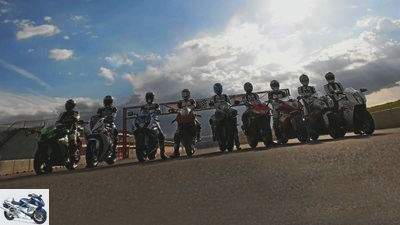
Jahn
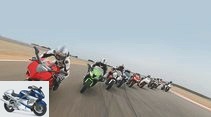
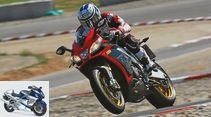
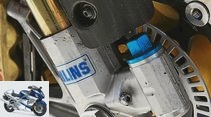

26th photos
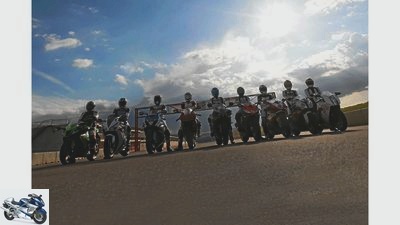
Jahn
1/26
The super athletes: Aprilia RSV4 Factory APRC, BMW S 1000 RR, Ducati 1199 Panigale S, Honda Fireblade, Kawasaki Ninja ZX-10R, KTM 1190 RC8 R, MV Agusta F4 RR, Suzuki GSX-R 1000, Yamaha YZF-R1 in the race track test. Which bike is the fastest on the circuit??
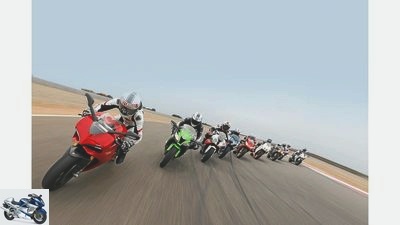
Jahn
2/26
The super athletes: Aprilia RSV4 Factory APRC, BMW S 1000 RR, Ducati 1199 Panigale S, Honda Fireblade, Kawasaki Ninja ZX-10R, KTM 1190 RC8 R, MV Agusta F4 RR, Suzuki GSX-R 1000, Yamaha YZF-R1.
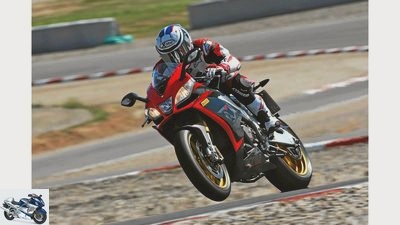
Jahn
3/26
Aprilia RSV4 Factory APRC.
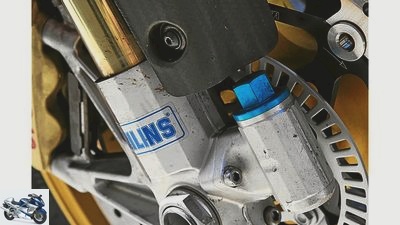
Jahn
4/26
Aprilia RSV4 Factory APRC: For a series chassis, the Aprilia “out of the box and onto the slopes” offers a very high level. With that a very tight pace is feasible. Annoying, however, that the front fender practically covers the pressure stage adjuster.
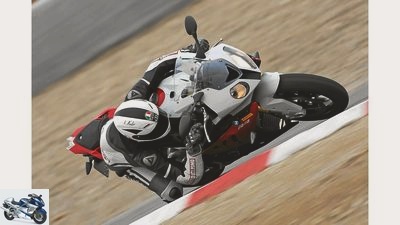
Jahn
5/26
BMW S 1000 RR.
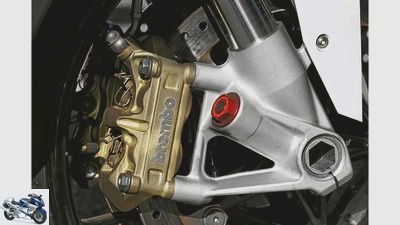
Jahn
6/26
BMW S 1000 RR: Please take a closer look, these brakes are a stunner. Only fighter jets are slowed harder by the catch hook when landing on an aircraft carrier. The damping of the fork can be adjusted with the ignition key.
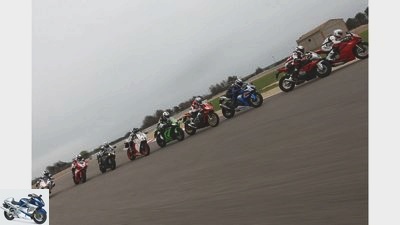
Jahn
7/26
The super athletes: Aprilia RSV4 Factory APRC, BMW S 1000 RR, Ducati 1199 Panigale S, Honda Fireblade, Kawasaki Ninja ZX-10R, KTM 1190 RC8 R, MV Agusta F4 RR, Suzuki GSX-R 1000, Yamaha YZF-R1.
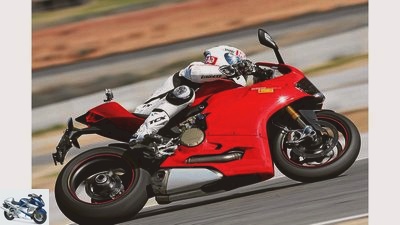
Jahn
8/26
Ducati 1199 Panigale S..
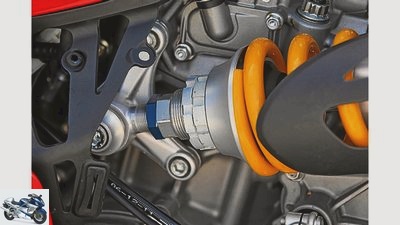
Jahn
9/26
Ducati 1199 Panigale S: The rock-hard shock absorber is also supported directly on the engine. The height adjustment of the shock absorber is hidden behind an astonishingly cheap popped plastic cover (which came off in the test). The pumping at the rear could not be cured with it.
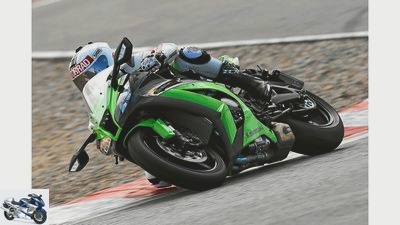
Jahn
10/26
Kawasaki ZX-10R.
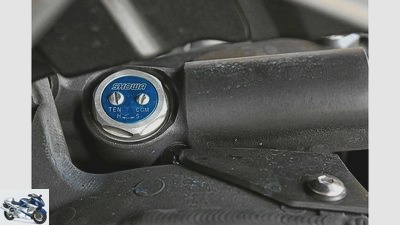
Jahn
11/26
Honda Fireblade: The rear section and strut couldn’t convince when dancing on the last groove. The adjustment screws can hardly be reached even with an inclined screwdriver, so twisted screws are preprogrammed.
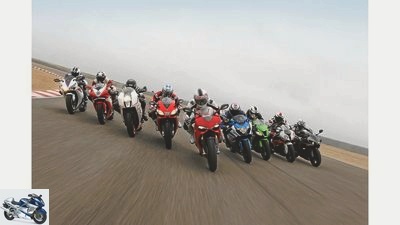
Jahn
12/26
The super athletes: Aprilia RSV4 Factory APRC, BMW S 1000 RR, Ducati 1199 Panigale S, Honda Fireblade, Kawasaki Ninja ZX-10R, KTM 1190 RC8 R, MV Agusta F4 RR, Suzuki GSX-R 1000, Yamaha YZF-R1.
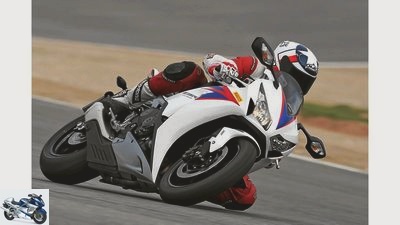
Jahn
13/26
Honda CBR 1000 RR Fireblade.
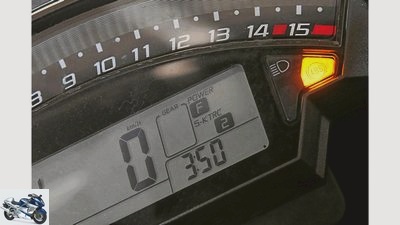
Jahn
14/26
Kawasaki ZX-10R: Keep it simple. Three modes for power and traction control, that’s enough. However, it should be possible to switch off the ABS for the racetrack. The light bar tachometer is nice to look at, but a clear and brightly lit shift light would be better on the racetrack.
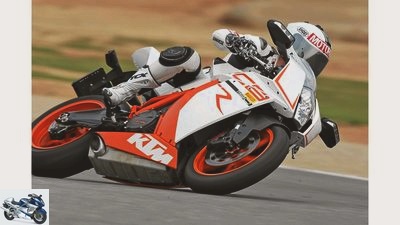
Jahn
15/26
KTM 1190 RC8 R..
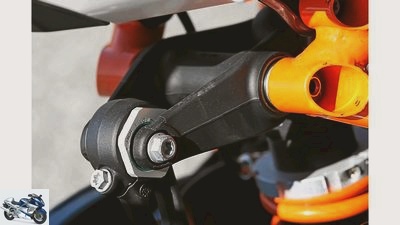
Jahn
16/26
KTM 1190 RC8 R: Simply ingenious and ingeniously simple: the various setting options for the chassis, including rear height adjustment, which can be done with on-board tools. Unfortunately, notches and levers touch down too early.
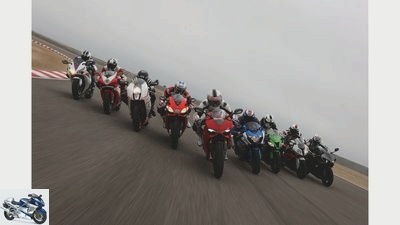
Jahn
17/26
The super athletes: Aprilia RSV4 Factory APRC, BMW S 1000 RR, Ducati 1199 Panigale S, Honda Fireblade, Kawasaki Ninja ZX-10R, KTM 1190 RC8 R, MV Agusta F4 RR, Suzuki GSX-R 1000, Yamaha YZF-R1.
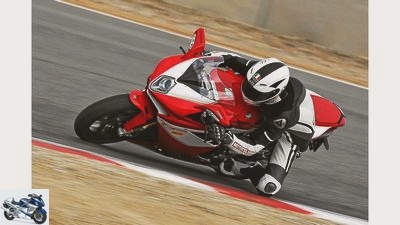
Jahn
18/26
MV Agusta F4 RR.
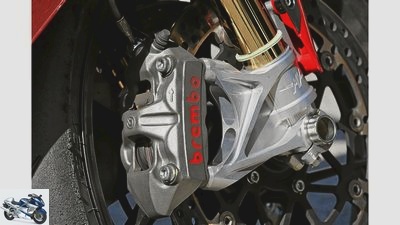
Jahn
19/26
MV Agusta F4 RR: The MV is a sculpture, beautiful to look at down to the last detail, the chassis rock solid. But overall, with its old-school seating position, it looked like it was from another era, and the engine set-up looked unfinished.
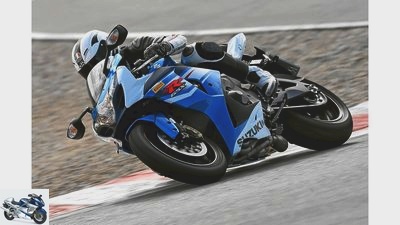
Jahn
20/26
Suzuki GSX-R 1000.
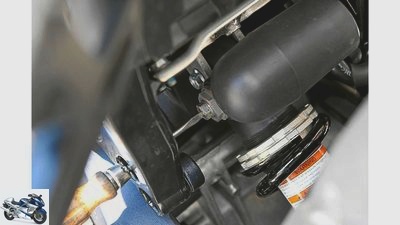
Jahn
21/26
Suzuki GSX-R 1000: She is of a good-natured, uncomplicated nature, even if the shock absorber reacts stubbornly to waves despite soft tuning. Cramp: To adjust, the side panel must be laboriously removed.
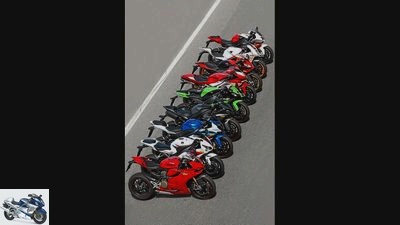
Jahn
22/26
The super athletes: Aprilia RSV4 Factory APRC, BMW S 1000 RR, Ducati 1199 Panigale S, Honda Fireblade, Kawasaki Ninja ZX-10R, KTM 1190 RC8 R, MV Agusta F4 RR, Suzuki GSX-R 1000, Yamaha YZF-R1.
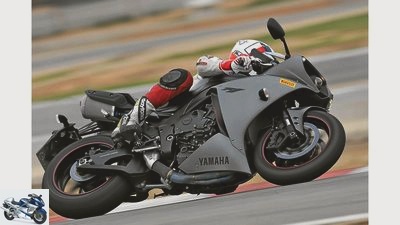
Jahn
23/26
Yamaha YZF-R1.
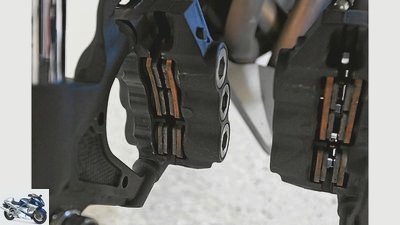
Jahn
24/26
Yamaha YZF-R1: The only six-piston stoppers in the field. Your split brake pads have no significant advantages. The R1 is also the only one of the four-cylinder engines active in international racing to have the exhausts in the rear.
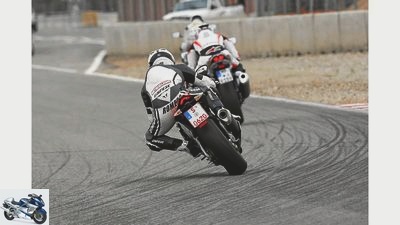
Jahn
25/26
Stripes pave their way.
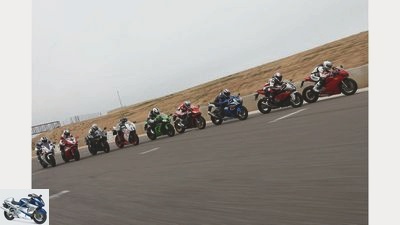
Jahn
26/26
Done! The Aprilia RSV4 Factory APRC wins the race track test. The engine and traction control are a powerful duo, which is part of an incredibly agile, precise chassis. Victory even without maximum power.
Comparison test: Supersports 2012
Test: superbikes on the racetrack
Of course, the nine superbikes can be maneuvered through everyday life without any problems and with pleasure or used for driving to work. But their real destiny is competition. On a closed route. And that’s what it’s all about now. Visor down, the pit light is green.
So people. Put your ears back, fasten the knee sliders, and off you go. After the current Superbike pack has passed the country road test like tigers in a cage, hardly knowing what to do with all their strength and speed, they can now flex their muscles. On the Spanish slope of Alcarrás.
Three pilots who have been tested at full throttle will squeeze the machines in search of the fastest lap. Ex-Supersport driver Christian Kellner, called “Kelle” for short, the Swedish Superbike champion Freddy Papunen and the TT-proven Spaniard Sergio Romero will take over the chase. So everything as usual. But this time there is a very special tension over the story. The bets are on whether the revised BMW can defend its top position or whether you won’t spit the Aprilia in the soup this time. Because the outcome is uncertain, the route from Alcarrás does not offer as many opportunities to convert sheer engine power as the GP circuit in Aragon last year.
Maybe the Kawasaki, which has been praised for its chassis, can also show off or the revised Honda can make a big impression? The big unknown in this equation, however, is this D.ucati Panigale, showered with advance praise and conditioned to life at the limit like no other.
Buy complete article

Comparison test: Supersports 2012
Test: superbikes on the racetrack
Yamaha YZF-R1 on the track. After all, the motorcycle that won the Superbike World Championship crown in 2009. And which was able to score plus points on the country road for its pleasant engine and a lot of comfort. In addition, the R1 was spiced up with traction control for 2012.
But the sporting laurels – nationally and internationally – have already faded a bit. And here and now there is nothing to be gained with comfort. So the Yamaha can boast here?
The four-cylinder with its unconventional firing order and the charming sound throws itself into the stuff, as if it wanted to punish all doubters lies, pulls out of the corners and roars with relish up the home straight. Hardly any vibrations, secure gear changes and smooth, easy-turning performance. That turns on.
But there is no kick in the top third of the engine speed, and the engine speed limit is not announced either in terms of performance or acoustically, because the engine, with its sonorous pitch, always fakes a lower engine speed. So it is always important to keep an eye on the well-positioned shift light so as not to get caught in the limiter by accident.
So the engine can still set accents, the chassis can’t. When turning in, a clear message on the handlebars is required, then the R1 arrows neatly on the targeted line around the corner. But throwing jaggedly from one incline to the next is only possible to a limited extent. The R1 looks trustworthy, but also heavy, not particularly nimble.
In addition, the spring elements are too soft to provide crisp stability when changing lean angles quickly. The highest total weight of 214 kg cannot be concealed. In addition, the sitting position appears more relaxed than sporty-focused. To find a clean line stress-free, certainly not the worst. If it goes on the last groove, the R1 just looks too doughy. In addition, the six-piston pliers in the front wheel can be dosed properly, but are blunt.
Jahn
The super athletes: Aprilia RSV4 Factory APRC, BMW S 1000 RR, Ducati 1199 Panigale S, Honda Fireblade, Kawasaki Ninja ZX-10R, KTM 1190 RC8 R, MV Agusta F4 RR, Suzuki GSX-R 1000, Yamaha YZF-R1.
After all, the four-cylinder reconciles at the exit of the curve with a full acceleration, although it should be a little more gentle on the gas. And it can also be let off the leash quite briskly. The traction control monitors the rear wheel very effectively. But in the end he simply lacks a good shot of top performance to really be at the front. The R1 has an average of 1: 43.370 min among the three pilots. With that you would have heated up the 600 at the same place two weeks ago.
What this time is worth will soon become apparent, because next, the newly renovated Suzuki GSX-R 1000 will enter the ring. At first, however, it looks like a familiar buddy, revision or not. Instruments, switches, tank, fairing supports, everything looks as it always has, seen a thousand times, familiar. The seating position, which is dominated by the bulbous tank and the somewhat idiosyncratic cranked, narrow handlebar stubs, as usual.
Thank god, that can also be said of the bearish engine. The longest-stroke four-cylinder in the field has always been known for its first-class performance. The current year is no exception. With fine throttle response, direct response and fat pressure from the middle, the Suzuki comes out of the corners. Its gear ratio fits perfectly, and the gear changes slip easily and precisely, so that it wastes little time when shifting. The brakes, which are much more committed than last year’s model and which Suzuki reliably catch at the end of the long straight, are also strengthened by the facelift.
Although the Suzuki has shed around five kilograms of hip gold, it is still more leisurely than lively nature. After all, 203 kilograms are not a highlight without ABS or other electronic helpers.
After all, the Suzi rushes neutrally through the following double links, and above all more precisely than the Honda. No, model maintenance has not made a razor-sharp precision iron out of the GSX-R 1000 this year either. The spring elements are still too soft for this. And yet the shock absorber only insufficiently processes the many blows and joints in the seemingly endless right-hand bend in front of the chicane.
There is always some movement on board, but the Suzuki manages – perhaps precisely because of this – to instill confidence in its driver. Because he always feels exactly what the motorcycle is doing and because it remains transparent and predictable. The Suzuki is adopting that trait that has always distinguished the Honda Fireblade: sociability. And she uses this ice cold for the first positive surprise in Alcarrás by leaving the Yamaha clearly behind with an average of 1: 41.938 min out of nine laps.
Meanwhile, the representative of the latest generation of Nippon superbikes is already warming up: the Kawasaki ZX-10R. She is the only representative of Japan who picked up the performance gauntlet that BMW threw down. And she is the only Japanese woman who has an electronic arsenal that is almost on par with ABS and traction control.
Is it enough? In any case, in the Superbike and Superstock World Championships, the ten are now very much up front. With a pithy howl she comes up the home straight, yelling clearly, the test stand had spewed out a whopping 197 hp, something has to be done.
With full sails the Kawasaki slams into the first corner. The change to the Pirelli racing skins has noticeably improved their handling. And already the first quick turns reveal the class difference in terms of chassis between the Greens and Yamaha / Suzuki.
Significantly tighter and stiffer, with more feedback and enormous cornering speed, the Kawasaki circles along the curbs. And with a lot of momentum into the next straight. The traction control unobtrusively but securely keeps the hindquarters in check. It slips smoothly through the chicane, looks harmonious and well balanced. The best conditions to convert all the power of the Kawa into terribly fast lap times.
But it’s not that simple. Because the green is a bit delayed at the apex of the curve after rolling phases and with a jolt on the gas, which easily takes the Kawa a little off the targeted line, especially in a great lean. What Kelle complains above all because it requires increased concentration on the part of the driver when applying the gas.
Jahn
BMW S 1000 RR.
When braking, the ZX-10R lies like a board, also thanks to the impeccable slip clutch. But their ABS brakes seem pale, and require firm grip for deceleration in keeping with their standing. The ABS-free brakes of previous tens made a snappier impression. In addition, the ABS is not set up sharply enough for the racetrack, complains Sweden racer Papunen, who even falls on the brakes after his fast laps.
But the biggest obstacle on the way to the top lap time is the engine’s speed-oriented performance characteristics, its weak center in connection with the long geared lower gears.
In order to get out of the corners with pepper, you have to try first course much more often than with the other two. And “when the performance really starts, you usually have to hit the brakes again because the next bend is coming,” diagnoses Christian. So the brilliant power of the Greens cannot be used to its full potential. And yet the ZX-10R is clearly ahead of the other Japanese with an averaged 1: 41.786 min.
Okay, dear four-cylinder, now it’s time to dress warmly. The Ducati 1199 Panigale S is preparing to pull the fur over your ears with a mighty thunder. The most powerful twin of all time, the lightest motorcycle in the field, armed to the teeth with the latest electronics. Engine brake management, ABS, traction control, electronically adjustable chassis, everything is there. With a murderous scream, the Duc dives into the home straight, bawls along the pit wall and sets off on the first lap. The stopwatches are ticking, now it’s getting serious.
The gearbox and automatic gearshift work much better than the old 1198, serving gear by gear on the 800-meter straight. End of start / finish, the first two left turns, which are combined into a long, opening arc, are a delight. No Ducati has ever been so easily, so easily peppered in the corners. When it comes to handling, she is now at the forefront. Braking deep into the tight corners is a snap with the wonderfully adjustable Brembos.
Incidentally, the EBC engine brake control had a transmission break in Alcarrás. On fast courses such as Mugello, Salzburg or Aragon, reducing the engine braking torque before fast corners may be helpful, but on the rather narrow slope of Alcarrás it was much more pleasant when the engine wasn’t cornering.
In no time the Duc has threaded its way through the chicane, the subsequent downhill left turns require a lot of confidence in the front wheel – the Duc offers it.
Still heavily reprimanded on the country road, the throttle response at the high revs here does not yet work with the necessary accuracy, but it does so much better. But with the Panigale, as with the Kawasaki, the speed at the apex of the bend should not drop too far, because only from 8000 rpm there is fire, but then it really does. Again and again the Ducati lifts the front wheel with an angry cry. 190 hp and this revving power are unique in the twin universe. But for Freddy Papunen, the spread of the gears does not always fit perfectly; at low speeds, the mandatory punch is sometimes missing from tight corners, and shifting is then the order of the day. Above all, however, the Ducati pumps powerfully with the hindquarters when accelerating out despite the very hard tuned shock absorber, which could not be got under control even with different setups.
The sovereign traction control left nothing to burn. But the grip on the rear wheel wasn’t completely convincing. In addition, the twin vibrates vigorously at high speeds, which makes the Duc somewhat strenuous to drive despite its impeccable handiness. Nonetheless, the Ducati pulverized the times of the four-cylinder units that had competed so far with an average of 1: 41.500 min. The price for this: the rear tire broke the sails after three quick turns. No other machine was so brutal with rubber.
Jahn
Ducati 1199 Panigale S..
But the tension rises, because now the Aprilia RSV4 Factory APRC is roaring out of the pit lane. The wonderful V4 sound alone makes all the hair on the back of the neck stand upright. Blessed with thoroughbred racing genes from the Superbike World Championship, crammed with electronics until you drop. Launch, wheelie, traction control – apart from ABS, everything is on board. Even in the first few meters, no one feels like a real racing motorcycle like them. How compact it is – it beds its rider like a jockey. Aggressive, focused, only focused on the next bend, the chassis taut, no crumple seat pads. Turning in is a pleasure. The Aprilia tilts almost greedily, and willingly lean ever deeper towards the asphalt without ever looking wobbly. Finds the perfect line almost intuitively. Zack, zack the chicane has been mastered. A dream. “A real racing plane,” Kelle will grin later. He is right. Even if not the strongest. But if its 180 hp are an announcement, the V4 hangs razor-sharp on the gas. Presses impressively from the apex of the curve. Simply great to enjoy your revving on the straights, even if an extra portion of bite wouldn’t hurt from 10,000 rpm. “For me the best bike. If I could wish for anything else, then a maximum of 10 hp ”, grins Sergio.
But performance isn’t everything. And the Aprilia has a lot to offer of the rest of a motorcycle. In addition to the first-class chassis, for example, wonderfully coordinated spring elements. The feeling for the front wheel is fantastic, and the speed at which you enter the corner is correspondingly high.
The traction control gently ironed out cockiness at the throttle grip in an inclined position. But be careful: if you turn the clutch fitting too far down in search of better ergonomics, you will ensure that the non-adjustable, far-protruding hand lever operates the traction control paddle every time you connect and, in the worst case, turns it off.
Although Kelle notes a slight flexing on the rear wheel when accelerating out in the limit area, there is nothing else to complain about about the chassis. Because the RSV4 fires over the straights that it only smokes. The gears are stepped through with ultra-jagged edges, and the gear changes are absolutely secure thanks to the perfectly adjusted automatic gearshift. The data recording reports 257 km / h at the end of the home straight, tied with the stronger Ducati.
So dozens of pairs of eyes stare at the stopwatches when the Italian roars across the home straight, and a murmur goes through the team when they stop averaged at 1: 40.728 minutes. Free, the last 10 hp, Sergio. Ducati bagged and the rest of the pack sent to their places.
But for how long? Now the air is finally burning. Because now comes the Bayern club, the BMW S 1000 RR. And that has cleared every opponent from the field since it appeared. Further refined electronics, improved handling and a shorter gear ratio, these are the innovations for the 2012 season.
The BMW has actually become a bit more agile, but there is still a long way to go when it comes to real handling artists. In the tight corners it is still not possible without commitment. The strength of its chassis in 2012 is not in its gazelle-like maneuverability, but rather in the serenity with which – although not as tight and directly tuned as with Aprilia – it takes fast and slow, narrow and wide, smooth and undulating curves, always safely conveyed. Even if it’s a little softer and allows a little more movement than is the case with the Ducati and especially the Aprilia.
To do this, the BMW can brake so that you run out of breath. Almost brutal, how the radially mounted Brembo pliers grab the BMW still full and stable. No question about it, it is difficult to crack in the braking zone.
But most impressive is still the sheer power of the Bavarian four-cylinder. Power is always and everywhere. The BMW pushes out of the corners, powers over the straights without a moment of weakness, pushes even further where the others are slowly losing their strength and does not give the driver a moment to breathe.
Jahn
KTM 1190 RC8 R..
But this sheer power in connection with the slightly shorter translation is not so easy to control. BMW tries to do a wheelie at every opportunity. And the electronics subito brings the front wheel back to the ground quite brusquely.
On the other hand, the traction control acts much more gently, almost imperceptibly, when exiting a curve. However, it is used quite often. “Maybe it intervenes a little too early, the power is not really realizable,” ponders Kelle. Together with the wheelie tendency, this is probably one of the reasons that at top speed, despite the performance advantage, it only creates a stalemate with Aprilia and Ducati. In the end, the BMW has to bow to the Aprilia by 17 hundredths of a second. Even if the S 1000 RR remains the absolute fastest lap with 1: 39.632 min. But what counts is the average of all three times drivers. And the Aprilia stays ahead.
Maybe the revised Honda Fireblade can provide a little surprise? But the first few laps leave behind helpless faces. The Honda feels sluggish, clumsy. Hardly wants to be kept on course on the targeted line in the curve and at the exit with a train. It looks like it’s hanging way too low in the rear suspension. The short check of the negative suspension travel does not reveal any abnormalities. Nevertheless, the spring is pretensioned at the rear and thus the rear is raised a little, plus the – pretty, but poorly accessible – damping valves of the shock absorber almost completely closed – and out again.
That works better, even a little faster than the Suzuki. But the impression of heaviness still remains, especially in the tricky chicane, where the slippery seat cushion also prevents intimate contact with the motorcycle. Really crisp steering precision and the relaxed balance, for which the Fireblade was valued up to now, are not achieved to the usual extent. But the engine shines with a wonderfully powerful middle. Pushes ahead well, only at the top it misses the brutal thrust like the Yamaha. And at the apex of the corner he could accelerate more gently. Above all, however, the strangely crumple, diffuse hindquarters irritate at the exit of the curve, despite exhausted damping reserves. The Blade deserved a better tuned shock absorber. But this dilutes the clear feeling for the limit area when accelerating vigorously in an inclined position and leaves little confidence when opening the gas. Especially since no traction control prevents ground damage in an emergency. And since the brakes are on the move, but not at the top level in terms of feedback, not even a tenths of a second can be made up at the corner entrance. In the end, the Honda ends up just ahead of the Yamaha with 1: 43.096 min.
But the air is far from out. After all, the MV Agusta F4 RR wants to have a say, confidently throwing its Corsacorte short-stroke engine, radially arranged valves, variable intake trumpets and the announcement of 201 hp into the ring. And with their highly acclaimed chassis, the Varese racers have always been good at music. With wonderful trumpets from its four pipes under the bench, the MV shoots on the track. On the first few kilometers she looks like the last representative of a bygone era of superbikes. Long the tank, low the handlebars, that results in a stretched, exhausting sitting position, which even the Ducati has since said goodbye.
But you shoot yourself at it, merge with the machine. In connection with the bomb-proof, rigid chassis, this produces terrific feedback from the road. The MV runs around the curves like on rails, the well-coordinated fork literally absorbs bumps and edges. Only the shock absorber goes a little carelessly over the many bumps. Nevertheless, the stability of the MV is enormous. With a lot of momentum and confidence, it is therefore the steep downhill, outward-hanging and terribly fast left curve in the middle part of the route. In the wavy braking zone in front of the following, endless right and the subsequent chicane, the pulse remains calm, even if the MV wobbles a bit when anchoring hard. Because she received excellent gripping, finely metered stoppers that still provide a constant pressure point even after tens of fast laps. All that’s missing is a bit more maneuverability, although the MV is not really behind here, but is still on a par with Yamaha and Suzuki. Only the push-up sitting position makes quick changes of lean angle a little more strenuous.
There are other reasons why it is not really enough at a top time. Although the short-stroke four-cylinder has enough top performance, its manners are too rough to be implemented on the technically demanding course. The MV quad runs rough, its throttle response is hard at the apex of the curve. Above all, however, the power delivery is too sharp. At 12,000 rpm, when the intake funnels switch to short intake paths, the engine seems to literally explode – and fidget in the limiter shortly afterwards. Finding the right time to change gear in the moderately precise gearbox is difficult, and the dull shift light does not help. “The engine takes away a lot of concentration, suddenly it cracks, you’re in the limiter,” Christian puffs after his laps. The other drivers feel the same way, and so the MV ranks ahead of Honda and Yamaha with an average of 1: 42.870 min.
Jahn
Kawasaki ZX-10R.
There is still the wild card in this match, the KTM RC8 R. Although completely free of electronic driving aids, but in terms of performance on a par with Honda, Yamaha and Suzuki, and much more agile, with great chassis and suspension elements. There could still be a surprise in the end on the technically demanding track. First of all, after the MV’s stooped posture, you first have to adjust yourself properly, because in a direct comparison the KTM’s relaxed seating position could easily pass as a sports tourer. For one or the other racer this is almost a bit too relaxed.
But it is certainly not a mistake to go easy on the chase instead of tense. And the KTM zigzags through the series of corners so that it just smokes. Its handling is among the best in the field, as light as a feather it folds towards the asphalt, right down to the deepest slopes. The twin hangs on the throttle as sharp as a rat and comes straight to the point with the slightest twist of the throttle grip. Bold pressure from the middle gives her an impressive start. In addition, the KTM provides enormous grip on the rear wheel and makes huge meters at the exit of a curve. On the sometimes short straights between two corners, she absolutely doesn’t have to hide from the stronger competition. Only the way on the throttle could be shorter in order to be able to open the throttle valves more quickly.
But even so, the KTM literally flies from curve to curve, hammering hard and vibrating pithily. Your acceleration is of course also due to the shortest overall gear ratio. The gears are turned down in no time at all, so you have to shift frequently. However, there is no automatic gearshift to facilitate this. For the home straight in Alcarrás, the overall translation fits. At 245 km / h, on a par with the Honda Fireblade, it reached the braking point.
When you brake hard, there is a little restlessness in the framework, but the super adjustable, bite-proof monobloc stoppers of the 1190 RC8 R are a poem. “With the same performance development, a little more pressure on top and she would be right at the front,” enthuses Freddy Papunen. In any case, he seems to feel right at home on the KTM, bends back until the notches, gearshift and brake levers chisel on the asphalt.
“She is not a BMW killer, but you can still have a lot of fun with her,” confirms Christian Kellner. The bottom line is 1: 42.870 min, with which the KTM even puts the much more powerful MV Agusta in its place. At the top, however, the palace revolution succeeded. The Aprilia has ousted the BMW from the throne. Even without ABS. The qualities of the chassis make the difference before the sheer force of the BMW. The Ducati shows what potential it has, but still needs fine-tuning. The end result also makes something else clear: the modern designs from Europe and the young Kawasaki set the tone. The older concepts, mainly of Japanese origin, have lost touch. The time is ripe for something new.
MOTORCYCLE scoring / test result
Jahn
Aprilia RSV4 Factory APRC.
| Max points | Aprilia | BMW | Ducati | Honda | Kawasaki | KTM | MV Agusta | Suzuki | Yamaha | total | 400 | 368 | 364 | 359 | 326 | 351 | 324 | 334 | 329 | 328 | placement | 1. | 2. | 3. | 8th. | 4th. | 9. | 5. | 6th. | 7th. |
1.Aprilia RSV4 Factory APRC
Done! The engine and traction control are a powerful duo, which is part of an incredibly agile, precise chassis. Victory even without maximum power.
2.BMW S 1000 RR
Despite ABS and unrivaled performance, the BMW is beaten. The chassis and the feasibility of the performance were decisive.
3. Ducati 1199 Panigale S.
She is not (yet) the big winner that everyone expected, but she is already very close to the top. The chassis is still missing fine-tuning.
4. Kawasaki ZX-10R
A powerful chassis and enormous top performance are their strengths. But that is not enough. Throttle response and weak torque cost points.
5th MV Agusta F4 RR
The chassis knows how to inspire. She has found the connection in handling. The engine tuning needs to be improved.
6. Suzuki GSX-R 1000
The revision did her good. An easy-going motorcycle, but without ups and downs. And without electronic helpers.
7. Yamaha YZF-R1
We like the pleasant, easy-to-implement performance characteristics of the engine. But the R1 is too sluggish for top results despite traction control.
8. Honda Fireblade
Like the R1, you can tell that the Blade has reached the end of its model cycle – in terms of chassis, performance and electronics.
9. KTM 1190 RC8 R
With the ungrateful last place actually beaten below value. Because the chassis is great, the V2 superbly tuned. But what good is that in a performance society?
Tires in the test
Jahn
Control is important because with the right air pressure, performance stands and falls.
When chasing times, of course, adequate super glue must be used. All machines were therefore equipped with Pirelli Supercorsa in the SC2 mixture.
The good-natured racing skins are not extreme representatives of their craft, they convince with good self-damping, excellent grip and an easily controllable limit area. It was driven in the dimensions 120/70 on the front wheel and 190/55 on the hindquarters. Only Aprilia and Ducati got a 200/55 strapped to the rim, which corresponds to the dimensions of the original equipment and what their traction controls are also tailored to.
Before the start, the tires were preheated to around 75 degrees with tire warmers so that the same conditions prevailed for all pilots. It was driven with an air pressure of 2.2 bar at the front and 2.0 bar at the rear when it was warmed up. Before heading out onto the slopes, a Pirelli technician meticulously checked the air pressure.
Alcarrás racetrack
archive
Alcarrás offers some enormous slopes and inclines. That curve before the target entry curve tempts you to brake late, but is garnished with a bump.
There is no shortage of racetracks in Spain. Just in the wider area of -Barcelona are Catalunya, Parcmotor Castelloli, Calafat and Aragon. Alcarrás is another, relatively new route.
It looks relatively harmless on paper. And you quickly got used to their curve sequences. But it’s not that easy to get a perfect lap on the 3743 meter long route. Many corners, contrary to the feeling, require late turning. Downhill corners like those after the chicane require a lot of feel for the front wheel. And above all the passage in the middle section of the route, which drops sharply by nine percent after a crest, requires a big heart. Only trust in the grip and the feeling for the bike decides how quickly you dare to go down. The subsequent, almost never-ending, fast right-hand bend, which is followed by a narrow chicane lined with bumps, is a particular challenge. Many hard braking maneuvers require the brakes to be fit and stamina. The tires are particularly challenged on the left flank. And after the chicane, there are six left turns before the first right-hand bend follows. A ticklish spot with tires not fully warmed up. A particular challenge for the chassis, however, are the sometimes considerable bumps.
Technical data / setup
Jahn
Aprilia RSV4 Factory APRC: For a series chassis, the Aprilia “out of the box and onto the slopes” offers a very high level. With that a very tight pace is feasible. Annoying, however, that the front fender practically covers the pressure stage adjuster.
Set up
| Aprilia | BMW | Ducati | Honda | Kawasaki | KTM | MV Agusta | Suzuki | Yamaha | Fork* |
| Rebound | 8 K | Item 6 | Item 14 | 4 ¼ U | 3 ¼ U | 10 K | 5 K | 4 U | 10 K | Pressure level | 8 K | Item 7 | Item 14 | 5 U | 4 ¼ U | 12 K | 6 K | 5 ¼ U | 5 K |
| Spring base | 6 U | 4 rows | hours. | 34 K | hours. | 3 U | 5 U | hours. | 10 U | Shock absorber * |
| Rebound | 12 K | Item 7 | Item 14 | ¼ U | 1 U | 15 K | 12 K | 2 ½ U | 12 K | Low compression | 9 K | Item 9 | Item 14 | ¼ U | ¾ U | 18 K | 10 K | 2 ¼ U | 7 K |
| Pressure level high | – | Item 4 | – | – | – | 1 ½ U | – | 3 ½ U | 2 ¼ U | Spring base | hours. | hours. | hours. | Item 4 | hours. | hours. | hours. | hours. | 12 U |
* K = clicks, U = revolutions, counted from the closed state; with spring base: U = revolutions counted from the open position, pos. = position, std. = standard
Technical specifications
| Aprilia | BMW | Ducati | engine |
| design type | Four cylinder 65 degree V engine | Four-cylinder in-line engine | Two cylinder 90 degree V engine | injection | Ø 48 mm | Ø 48 mm | Ø 68 mm |
| coupling | Multi-disc oil bath clutch (Anti-hopping) |
Multi-disc oil bath clutch (Anti-hopping) |
Multi-disc dry clutch (Anti-hopping) |
Bore x stroke | 78.0 x 52.3 mm | 80.0 x 49.7 mm | 112.0 x 60.8 mm |
| Displacement | 1000 cm3 | 999 cm3 | 1198 cm3 | compression | 13.0: 1 | 13.0: 1 | 12.5: 1 |
| power | 132.4 kW (180 PS) at 12500 rpm |
142.0 kW (193 hp) at 13,000 rpm |
143.0 kW (195 hp) at 10750 rpm |
Torque | 115 Nm at 10000 rpm | 112 Nm at 9750 rpm | 132 Nm at 9000 rpm |
| landing gear | frame | Bridge frame made of aluminum | Bridge frame made of aluminum | Aluminum monocoque |
| fork | Upside-down fork, Ø 43 mm | Upside-down fork, Ø 46 mm | Upside-down fork, Ø 43 mm | Steering damper | hydraulically | hydraulically | hydraulically |
| Brakes front / rear | Ø 320/220 mm | Ø 320/220 mm | Ø 330/245 mm | Assistance systems | Traction control | ABS / traction control | ABS / traction control |
| bikes | 3.50 x 17; 6.00 x 17 | 3.50 x 17; 6.00 x 17 | 3.50 x 17; 6.00 x 17 | tires | 120/70 ZR 17; 200/55 ZR 17 | 120/70 ZR 17; 190/55 ZR 17 | 120/70 ZR 17; 200/55 ZR 17 |
| Tires | Pirelli Diablo Super Corsa SP, front “C” |
Metzeler Racetec K3 Interact | Pirelli Supercorsa SP | Dimensions + weights |
| wheelbase | 1420 mm | 1423 mm | 1437 mm | Steering head angle | 65.5 degrees | 66.0 degrees | 65.5 degrees |
| trailing | 105 mm | 99 mm | 100 mm | Front / rear suspension travel | 120/130 mm | 120/130 mm | 120/130 mm |
| Seat height ** | 840 mm | 810 mm | 820 mm | Weight with full tank ** | 205 kg | 209 kg | 195 kg |
| Payload ** | 201 kg | 196 kg | 175 kg | Tank capacity / reserve | 17.0 liters | 17.5 liters | 17.0 liters |
| Service intervals | 10,000 km | 10,000 km | 12,000 km | price | 22590 euros | 16 100 euros | 24 490 euros |
| Price test motorcycle | 22590 euros | 17 891 euros *** | 24 490 euros | Additional costs | around 287 euros | around 264 euros | around 345 euros |
| MOTORCYCLE readings | Top speed * | 290 km / h | 299 km / h | 296 km / h |
| acceleration | 0-100 km / h | 3.2 sec | 3.2 sec | 3.2 sec |
| 0-140 km / h | 4.5 sec | 4.6 sec | 4.6 sec | 0-200 km / h | 7.5 sec | 7.2 sec | 7.6 sec |
| Draft | 60-100 km / h | 3.7 sec | 3.3 sec | 3.9 sec |
| 100-140 km / h | 3.5 sec | 3.0 sec | 3.6 sec | 140-180 km / h | 3.4 sec | 3.0 sec | 4.7 sec |
| consumption | Consumption highway | 6.1 liters, super | 5.6 liters, super / plus | 6.1 liters, super |
| Reach country road | 279 km | 313 km | 279 km |
| Honda | Kawasaki | KTM | engine |
| design type | Four-cylinder in-line engine | Four-cylinder in-line engine | Two cylinder 75 degree V engine | injection | Ø 46 mm | Ø 47 mm | Ø 52 mm |
| coupling | Multi-disc oil bath clutch (Anti-hopping) |
Multi-disc oil bath clutch (Anti-hopping) |
Multi-disc oil bath clutch | Bore x stroke | 76.0 x 55.1 mm | 76.0 x 55.0 mm | 105.0 x 69.0 mm |
| Displacement | 1000 cm3 | 998 cm3 | 1195 cm3 | compression | 12.3: 1 | 13.0: 1 | 13.5: 1 |
| power | 130.7 kW (178 hp) at 12,000 rpm |
147.0 kW (200 hp) at 13,000 rpm |
129.0 kW (175 hp) at 10250 rpm |
Torque | 112 Nm at 8500 rpm | 112 Nm at 11500 rpm | 127 Nm at 8000 rpm |
| landing gear | frame | Bridge frame made of aluminium |
Bridge frame made of aluminium |
Tubular space frame from steel |
| fork | Upside-down fork, Ø 43 mm |
Upside-down fork, Ø 43 mm |
Upside-down fork, Ø 43 mm |
Steering damper | electronic / hydr. | hydraulically | hydraulically |
| Brakes front / rear | Ø 320/220 mm | Ø 310/220 mm | Ø 320/220 mm | Assistance systems | SECTION | ABS / traction control | – |
| bikes | 3.50 x 17; 6.00 x 17 | 3.50 x 17; 6.00 x 17 | 3.50 x 17; 6.00 x 17 | tires | 120/70 ZR 17; 190/50 ZR 17 | 120/70 ZR 17; 190/55 ZR 17 | 120/70 ZR 17; 190/55 ZR 17 |
| Tires | Bridgestone S 20 “G” | Bridgestone BT 016 “CC” | Dunlop Sportsmart | Dimensions + weights |
| wheelbase | 1410 mm | 1425 mm | 1425 mm | Steering head angle | 66.8 degrees | 65.0 degrees | 66.7 degrees |
| trailing | 96 mm | 107 mm | 97 mm | Front / rear suspension travel | 120/135 mm | 120/125 mm | 120/120 mm |
| Seat height ** | 830 mm | 810 mm | 820-840 mm | Weight with full tank ** | 209 kg | 200 kg | 205 kg |
| Payload ** | 170 kg | 178 kg | 175 kg | Tank capacity / reserve | 17.7 liters | 17.0 liters | 16.5 liters |
| Service intervals | 6000 km | 6000 km | 7500 km | price | 15,990 euros | 15 495 euros | 16 295 euros |
| Price test motorcycle | 16 110 euros **** | 16 495 euros ***** | 16 295 euros | Additional costs | around 295 euros | around 170 euros | around 200 euros |
| MOTORCYCLE readings | Top speed * | 293 km / h | 295 km / h | 287 km / h |
| acceleration | 0-100 km / h | 3.1 sec | 3.3 sec | 3.2 sec |
| 0-140 km / h | 4.5 sec | 4.6 sec | 4.8 sec | 0-200 km / h | 7.4 sec | 7.3 sec | 8.2 sec |
| Draft | 60-100 km / h | 3.6 sec | 3.9 sec | 3.1 sec |
| 100-140 km / h | 3.4 sec | 3.5 sec | 3.2 sec | 140-180 km / h | 3.0 sec | 3.6 sec | 3.3 sec |
| consumption | Consumption highway | 5.1 liters, great | 5.1 liters, great | 5.6 liters, super / plus |
| Reach country road | 347 km | 333 km | 295 km |
| MV Agusta | Suzuki | Yamaha | engine |
| design type | Four-cylinder in-line engine | Four-cylinder in-line engine | Four-cylinder in-line engine | injection | Ø 46 mm | Ø 44 mm | Ø 45 mm |
| coupling | Multi-disc oil bath clutch (Anti-hopping) |
Multi-disc oil bath clutch (Anti-hopping) |
Multi-disc oil bath clutch (Anti-hopping) |
Bore x stroke | 79.0 x 50.9 mm | 74.5 x 57.3 mm | 78.0 x 52.2 mm |
| Displacement | 998 cm3 | 999 cm3 | 998 cm3 | compression | 13.4: 1 | 12.8: 1 | 12.7: 1 |
| power | 147.7 kW (200 PS) at 13400 rpm |
136.0 kW (185 hp) at 11500 rpm |
133.9 kW (182 PS) at 12500 rpm |
Torque | 114 Nm at 9200 rpm | 117 Nm at 10000 rpm | 116 Nm at 10000 rpm |
| landing gear | frame | Tubular space frame from steel |
Bridge frame made of aluminium |
Bridge frame made of aluminium |
| fork | Upside-down fork, Ø 43 mm |
Upside-down fork, Ø 43 mm |
Upside-down fork, Ø 43 mm |
Steering damper | hydraulically | electronic / hydr. | electronic / hydr. |
| Brakes front / rear | Ø 320/210 mm | Ø 310/220 mm | Ø 310/220 mm | Assistance systems | Traction control | – | Traction control |
| bikes | 3.50 x 17; 6.00 x 17 | 3.50 x 17; 6.00 x 17 | 3.50 x 17; 6.00 x 17 | tires | 120/70 ZR 17; 190/55 ZR 17 | 120/70 ZR 17; 190/50 ZR 17 | 120/70 ZR 17; 190/55 ZR 17 |
| Tires | Pirelli Supercorsa SP | Bridgestone S 20 “F” | Michelin Power Pure, front “A” | Dimensions + weights |
| wheelbase | 1430 mm | 1405 mm | 1415 mm | Steering head angle | 66.0 degrees | 66.5 degrees | 66.0 degrees |
| trailing | 100 mm | 98 mm | 102 mm | Front / rear suspension travel | 120/120 mm | 120/130 mm | 120/120 mm |
| Seat height ** | 830 mm | 810 mm | 820 mm | Weight with full tank ** | 213 kg | 203 kg | 214 kg |
| Payload ** | 182 kg | 182 kg | 181 kg | Tank capacity / reserve | 17.0 liters | 17.5 liters | 18.0 liters |
| Service intervals | 6000 km | 6000 km | 10,000 km | price | 22 900 euros | 14 790 euros | 15 750 euros |
| Price test motorcycle | 22 900 euros | 14 790 euros | 15 750 euros | Additional costs | around 275 euros | around 220 euros | around 295 euros |
| MOTORCYCLE readings | Top speed * | 298 km / h | 295 km / h | 285 km / h |
| acceleration | 0-100 km / h | 3.4 sec | 3.2 sec | 3.3 sec |
| 0-140 km / h | 4.9 sec | 4.5 sec | 4.7 sec | 0-200 km / h | 7.8 sec | 7.5 sec | 7.8 sec |
| Draft | 60-100 km / h | 3.9 sec | 3.4 sec | 3.5 sec |
| 100-140 km / h | 3.4 sec | 3.1 sec | 3.5 sec | 140-180 km / h | 3.2 sec | 3.2 sec | 3.6 sec |
| consumption | Consumption highway | 6.8 liters, super | 5.0 liters, super | 6.0 liters, super |
| Reach country road | 250 km | 350 km | 300 km |
* Manufacturer information; ** MOTORCYCLE measurements; *** including ABS and DTC (1230 euros), automatic gearshift (364 euros) and heated grips (197 euros); **** incl. racing windshield (120 euros); ***** including ABS (1000 euros)
Related articles
-
Track test super nakeds against superbikes
65 Pictures www. 1/65 It does not have a spring strut redirection with an eccentric to adjust the rear height like the RC8 R does. That helps …
-
Superbikes 2012 – The super athletes on the country road
30th photos 1/30 The super athletes: Aprilia RSV4 Factory APRC, BMW S 1000 RR, Ducati 1199 Panigale S, Honda Fireblade,…
-
Superbikes 2012 – The super athletes on the high-speed track
18th photos 1/18 The super athletes: Aprilia RSV4 Factory APRC, BMW S 1000 RR, Ducati 1199 Panigale S, Honda Fireblade,…
-
Seven superbikes in the racetrack test
r-photography.info 46 photos r-photography.info 1/46 Aprilia RSV4 RF, BMW S 1000 RR, Ducati 1299 Panigale S, Honda Fireblade SP, Kawasaki ZX-10RR, Suzuki…
-
Comparison test of super athletes under 1000 cubic meters
Jahn 22 pictures Jahn 1/22 The Kawasaki ZX-6R 636 wins the comparison test before the Suzuki GSX-R 750. Jahn 2/22 super sports car under 1000 cubic meters in the test. It…
-
Comparison test: Superbikes 2012
32 pictures 1/32 Yamaha YZF-R1, MV Agusta F4 RR, Kawasaki ZX 10-R, BMW S 1000 RR and Honda Fireblade C-ABS in the super sports car …
-
Comparison test of the 1000 super sports car
Jaime de Diego 38 pictures fact 1/38 Yamaha demands 14895 euros for their completely new R1 super sports car. fact 2/38 Even without ABS, the Fireblade would …
-
Comparison test of the 1000 super sports car in 2006
fact comparison test of the 1000 super sports car 2006 The show must go on The mystery repeats itself. Whenever we think that there is nothing more …
-
Supersport motorcycles in comparison test on the racetrack
Bilski 34 photos Bilski 1/34 Track test super athlete. Bilski 2/34 … The fact that he chose the Suzuki for this high-speed posing speaks for its…
-
2017 super sports car in the country road comparison test
fact 28 pictures factstudio.de 1/28 The 2017 superbikes were just dueling on the racetrack, now the focus is on the country road …